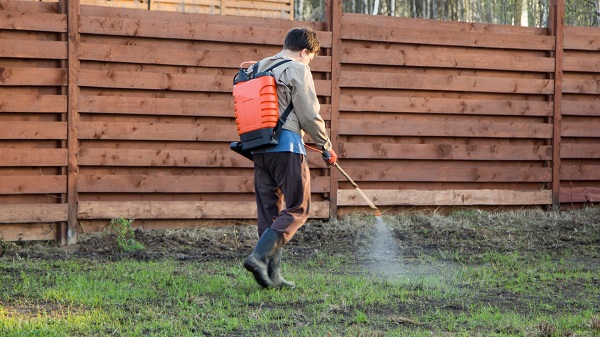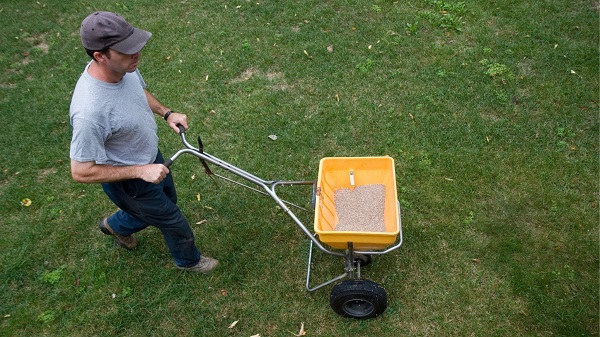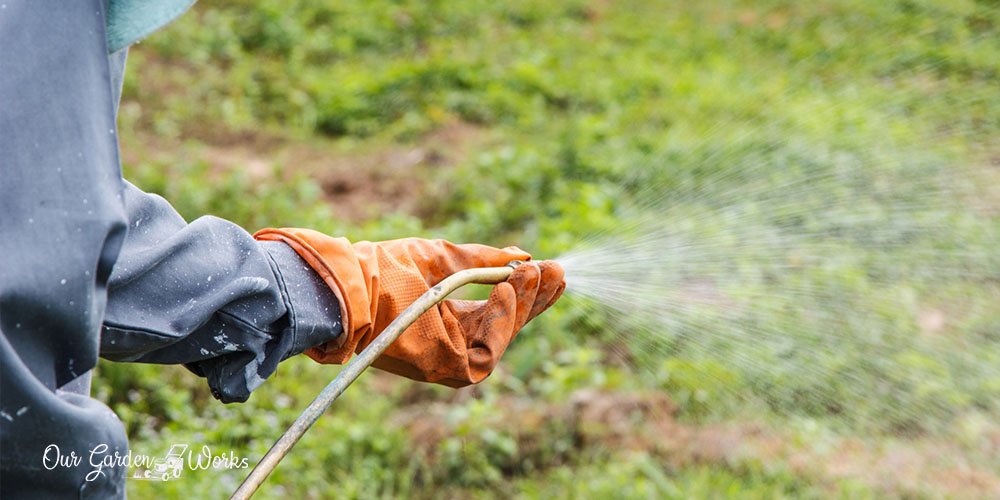The use of pre-emergent and post-emergent herbicides were the horticultural norm until weed & feed came along.
Tons of debates have been around about pre-emergent vs. weed & feed and different opinions about their respective benefits confuse a lot of people.
The underlying question is, does weed & feed make an ideal alternative to pre-emergent, or is it just another fad practice?
In this post, we will share how pre-emergent and weed and feed works and why they are often compared with each other.
We highly recommend that you should be guided by this post before you start buying any herbicide because it can be easy to get swayed by products that do not match the solution you need.
Pre-emergent vs. Weed & Feed: Which is better?
Pre-emergent herbicides are used to create a chemical layer on the topsoil to prevent weed seeds from developing vital plant parts, like roots and shoots.
It is used during the germination stage of the weed seeds to maintain the lawn or keep plant beds weed-free. Initially, pre-emergent is used for controlling crabgrass infestations.
Weed & feed, on the other hand, are a type of herbicide that offers both plant food and pre-emergent herbicide for both crabgrass and broadleaf weeds. The manufacturers of this herbicide claim an economical benefit for doing two tasks at once which saves your time and money.
Both weed and feed and pre-emergent are good for use on lawns but applying weed & feed at the wrong time can greatly affect the grass and harm the local ecosystem.
Pre-emergent is often applied in spring wherein the rain will activate its weed-killing effect. However, if weed & feed is applied in spring it can pose possible overfertilization that can burn the grass, encourage weeds, and cause weak grass growth.
Most professional gardeners and landscape artists argue that there’s a proper time for weeding and fertilizing the grass.
The best time to fertilize the grass is when it is actively growing and hungry for nutrients. With that, the nutrients will not sit in the soil for a long time and cause a chemical burn.
The active growth of grass which is best for fertilization usually falls in late spring or fall for both warm-season and cool-season grasses.
On the other hand, the best time to apply herbicides is during early spring or late fall just before the cool-season grass starts to sprout.
Why Weed & Feed Herbicides Are Not Ideal For Lawns?

While weed and feed herbicides have good intentions to make lawn care easier, it raises a lot of eyebrows among the gardening community.
If you’re going to ask them about pre-emergent vs. weed & feed, they will no doubt opt for pre-emergent not because it is the traditional method but for the following reasons:
(1) According to lawn experts, weeds are best killed when they are dormant, not when they are actively growing with grass.
(2) Feeding the grass should be done when the grass is actively growing, which often happens when the weeds are also sprouting. Therefore, most gardeners think that weed & feed is bad timing for both feeding and weeding since they need to have their respective time.
(3) Using weed and feed as a substitute for fertilizer will spread toxic chemicals in your lawn without the assurance that there are weeds to kill, to begin with. The rule of thumb is to only use chemicals in the garden as needed not to pose harm to the local ecosystem.
(4) Weed & feeds contain the toxic chemical Atrazine that can kill young trees and shrubs.
(5) Birds feed on weeds and feed pellets and granules which will pose a threat to their declining populations.
(6) Excess herbicides in the lawn will leach and be washed by rainwater leading it to natural bodies of water and affecting marine life.
(7) Weed & feeds are plain wasteful since it is often used to treat areas with no weeds that will absorb the herbicide and no grass that can absorb the fertilizer.
Aside from the numerous reasons mentioned above, weed & feed is so controversial that a country bans them for agricultural use.
In 2008, weed and feed were banned in Alberta, Canada due to the negative effects of 2, 4-D on aquatic organisms. According to studies, the chemical is highly mobile and can cause chemical run-off to waterways.
Did You Know?
In the pursuit of finding a natural way to inhibit the growth of weeds, a university professor found potential in using corn gluten meal or CGM, a natural pre-emergent.
However, recent studies and trials using CGM showed some reasons why it is not a one-size-fits-all solution. These are the findings:
- CGM only has the potential to be a pre-emergent agent for weeds.
- Unlike other herbicides, CGM is not selective and can inhibit the growth of desirable plants like grass.
- CGM is way more expensive to use on large-scale agricultural use.
- The pre-emergent ability of CGM only works in fields in the midwest US but fails to show the same effects in other parts of the country.
The Dangers of Using Weed and Feed to Human Health
The excess chemicals and fertilizer that come off from weeds & feeds can pose a threat to the health of your family and friends.
Here are some of the precautions listed by medical experts and government agencies against weed and feed:
- Icahn School of Medicine at Mount Sinai warns the public about the harmful chemicals found in weed and feed killers like glyphosate and surfactants like polyoxyethylene amine (POEA). They can cause health concerns like dizziness, diarrhea, breathing difficulty, and other health conditions.
There’s also an increased risk for cancer for people exposed to herbicides due to the organophosphates found in chemical herbicides and insecticides. It is based on studies conducted in the US, Canada, and Italy.
When To Fertilize Lawn Based on Grass Type?

Since weed & feed is a more likely counterproductive option, novice gardeners often wonder when is the best time to fertilize the grass.
To give you some context, here are the best times to fertilize some well-known grass varieties:
- Kentucky bluegrass: Fall (50℉-65℉).
- Tall fescue: Late summer to early fall (60℉-65℉).
- Fine fescue: Late summer to early fall and early spring (50℉-75℉).
- Bahiagrass: Late spring to summer (85℉-95℉).
- Centipedegrass: Late spring to early summer (70℉ and above).
- St. Augustine grass: Spring and summer (80℉-100℉).
- Bermudagrass: Late spring to summer (95℉-100℉).
- Zoysiagrass: Late spring and early summer (70℉-79℉).
When fertilizing your lawn, make sure to check the soil pH level and that you’re using the correct NPK ratio based on what your lawn needs.
In some cases, the mulch used for lawns like sawdust leaches nitrogen into the soil. So, the fertilizer that you should use is all-purpose fertilizer rather than something that has high nitrogen content.
Another tip in lawn fertilization is to delay application if the grass is not yet growing due to excessive spring rain and long winter.
Pro Tip: Did you know that weed and feed products don’t always show the word weed and feed on their labels? The manufacturers can mask their products as weed killer plus fertilizer or crabgrass killer + fertilizer.
When is The Best Time To Kill Weeds?
The best time to kill weeds is when they are dormant. So, for warm-season grass varieties that would be in early spring wherein the temperature and the ground are still cool enough to prevent seed germination.
Fall is the best time to apply pre-emergent herbicides to deal with weeds that emerge in cool-season grass lawns.
To avoid having excessive chemicals in your lawn and keep the negative effects of chemical herbicides at bay, make sure that you will only use herbicides if you have medium to heavy infestations of weeds.
If there are only a few weeds that pop out in the ground, you should give spot treatment a try first.
According to Iowa State University, there are three-time windows for every gardener to apply herbicides. However, it comes with its specific pros and cons:
Too Early Pre-emergent Application
If you’re too eager to kill the weeds, applying herbicides a month or three weeks before seeding can give you enough window for the rain to activate the herbicide.
Therefore, you can enjoy seeding on a weed-free lawn in late spring. Also, you’ll have more time to do other lawn work.
The disadvantage of weeding your lawn too early is the shorter residual effect or protection of the herbicide.
The herbicide may lose its effect on the lawn when you start preparing the soil or adding amendments. Tillage itself can expose the dormant weed seeds buried in the soil.
Pre-plant Pre-emergent Application
Pre-plant herbicide application is probably the most common practice used by gardeners for lawns.
With perfect weather conditions, it is more effective in dealing with emerging annual weeds, making it a just-in-time solution. The residual effect of the herbicide also extends to the growing stage of the grass.
The biggest risk in pre-plant herbicide application is the heavy dependence on rain to activate the herbicide. Weeds can escape the blanket of herbicide chemicals if there’s little to no rain within one week before planting or seeding.
Post-planting Pre-emergent Application
If you apply herbicide too late in the season, you may still control a few weeds and extend the residual effect until summer.
However, there’s a high chance that the weed seeds have already sprouted which will require you to use post-emergent herbicides. Lastly, the weeds may have started to compete with grass.
Power of Pre-emergents in Heavy Weed Infestations
Weed management using pre-emergents based on their efficacy and control will remain a more reliable solution than weed and feed. It is easy to control the chemical spread and prevents chemical runoff in waterways.
Aside from that, here are some reasons why every gardener should opt for pre-emergent over weed and feed:
- The proper timing is crucial for pre-emergent since it is activated by rain Also, it does not interfere with the chemical buildup in the soil.
- Pre-emergent has a valuable contribution to the prevention of herbicide-resistant weeds.
- The chemicals that you will apply to the soil are controlled and are less likely to cause leaching and pose threats to aquatic life.
- Pre-emergent herbicides make you a more responsible gardener even though you’re still using chemicals.
Final Thoughts
We hope that this post helped you realize the difference between pre-emergent vs. weed & feed. Though both of them contain chemicals, pre-emergent remains a more controlled weed management system than weed & feed.
Also, we hope that you learned the perfect timing in applying herbicide and fertilizing grass and the reason why they can’t be done in one single application.
Based on everything you learned in this post, are you still going to try weed & feed? Let us know in the comments what you think about it.
Also, please share this post with your friends who are avid fans of weed & feed to help them realize the threat that it can pose to their gardens and health.
